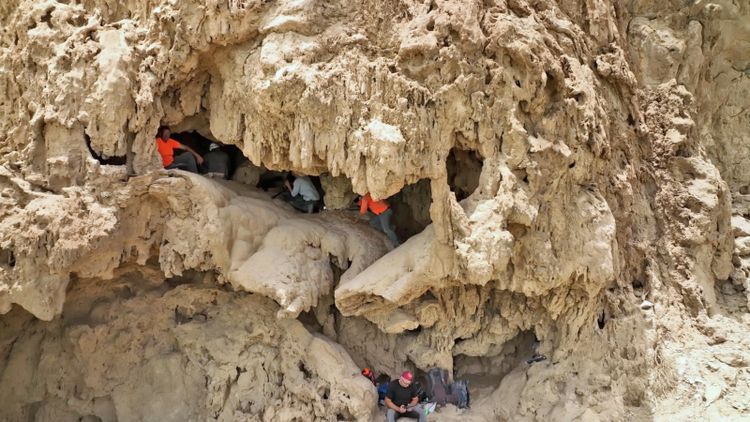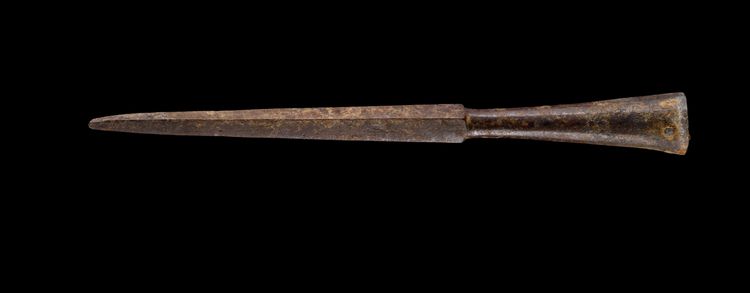Researchers called the find ‘dramatic evidence of a specific moment in history’ likely tied to the Bar Kokhba Revolt 1,900 years ago
A fascinating discovery in the Judean Desert: archaeologists unearthed a cache of well-preserved Roman weapons, including four swords and a shafted pilum weapon, believed to be around 1,900-years-old.
The ancient artifacts were hidden in a crevice inside a cave located in the Ein Gedi Nature Reserve.

The cache was discovered by accident during a visit to the cave for a different purpose. In the same cave fifty years ago, an ink inscription written in ancient Hebrew script was found on a stalactite, dating back to the First Temple period. Dr. Asaf Gayer of Ariel University, geologist Boaz Langford of the Hebrew University of Jerusalem’s Cave Research Center, and Shai Halevi, a photographer from the Israel Antiquities Authority, went to photograph the Paleo-Hebrew inscription using multispectral photography, hoping to reveal obscured parts of the text. It was during their visit that Gayer spotted the Roman pilum weapon concealed in a deep crevice.
The Israel Antiquities Authority’s Archaeological Survey Team was alerted to the discovery, prompting a meticulous investigation of the cave’s crevices. They uncovered four Roman swords in what was described as an almost inaccessible crevice on the upper level of the cave, pointing to the purposeful concealment of the likely stolen weapons.




The swords themselves are described as exceptionally well-preserved, with three of them still sheathed in wooden scabbards. Three of the swords have iron blades measuring 60 to 65 centimeters (23 to 25 inches) long, with handles made of wood or metal. The fourth is shorter, with a blade measuring approximately 45 centimeters (17 inches), identifying it as a ring-pommel sword. Leather strips and wood and metal finds belonging to the swords were also uncovered.
“Finding a single sword is rare—so four? It’s a dream! We rubbed our eyes to believe it,” say the researchers.
According to Rabbi Amichai Eliyahu, the Minister of Heritage, “We are once again presented with thrilling findings from the Judean Desert that offer a glimpse into the daily lives of our ancestors who resided in this area about 2,000 years ago.”
Researchers have yet to determine the full story behind the cache of weapons, but they believe that they were stashed by Judean rebels to avoid detection by the Roman authorities.
“The hiding of the swords and the pilum in deep cracks in the isolated cave north of Ein Gedi hints that the weapons were taken as booty from Roman soldiers or from the battlefield, and purposely hidden by the Judean rebels for reuse,” says Dr. Eitan Klein, one of the directors of the Judean Desert Survey Project.
“Obviously, the rebels did not want to be caught by the Roman authorities carrying these weapons.
Researchers from the Israel Antiquities Authority and Ariel University called the find “dramatic evidence of a specific moment in history.”




Additional investigations and research will aim to determine the historical event that led to the concealment of these weapons, and whether it is linked to the Bar Kokhba Revolt that occurred between 132 and 135 CE.
In response to the discovery, an archaeological excavation of the cave was initiated by the Israel Antiquities Authority, uncovering artifacts dating back to the Chalcolithic period (approximately 6,000 years ago) and the Roman period (around 2,000 years ago).
The discovery was unveiled during a press conference with Eli Escusido, director of the Israel Antiquities Authority, and the researchers. The findings are part of the launch of the book ‘New Studies in the Archaeology of the Judean Desert: Collected Papers,’ which showcases recent archaeological discoveries from the Judean Desert Survey Project.
Read more stories like this:
• Israeli archeologists uncover ‘longest’ Second Temple era aqueduct in Jerusalem >>
• City of David canals leave archeologists with more questions than answers >>
• Israeli youth discovers ‘magical mirror’ during a leadership survival course >>
This post was originally published on this site be sure to check out more of their content.







